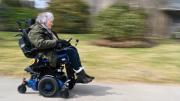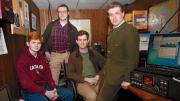Images are integral to the way human beings understand the world around them. As a physician and a photographer, Judith R. Peterson ’82 knows that, particularly in the world of medicine, images can help people comprehend how their own bodies function, and think critically about larger issues.
Today Peterson works as a photographer primarily for the website of South Dakota Public Broadcasting’s On Call. The live, hour-long show, hosted by Dr. Rick Holm, features physicians from across the state who discuss different medical and public-health issues each week. The website offers full episodes of the show and related editorials by Holm; Peterson’s photographs appear within these editorials to elucidate the complex subject matter. “Dr. Holm specifically wanted a physician and artist,” she explains. “He felt that a physician would bring a different level of understanding to [the material].”
“I’m trying to achieve a different perspective that’s helpful to the public in thinking about the core issue s: birth, death, life, healthcare, caring for elderly relatives, access to adoption,” and more, Peterson says. Rather than presenting straightforward pictures of people personally affected by a given topic, her photographs present more abstract images. For Holm’s essay on adoption, for example, Peterson photographed a single pink rose enveloped by red roses. “It shows beauty that is not exactly like we ourselves are, but [that] we can embrace,” she says. For an essay on congestive heart failure, she photographed stagnant water, tinting it red “so people could get the image of blood pooling, not being effectively pushed around in the body.” Some of her work touches upon the causes of medical conditions, rather than the symptoms. For an essay on diabetes, she explains, “I drove around until I found a playground that had no children—just a row of empty swings—and I photographed it” to emphasize how lack of physical activity can lead to childhood obesity…and diabetes.
Peterson, a specialist in physical medicine and rehabilitation, has always been interested in art and healing: in medical school, she took technical photographs for textbooks; before moving to South Dakota she was a rehab consultant for the Pennsylvania Ballet; she is now on the board of the Washington Pavilion of Arts and Science in Sioux Falls. “My life has been involved in arts medicine,” she notes, “working with people [doing] a lot of nonstandard activities.” Because her On Call photography can reach a wide audience, she says her mission in selecting images “is to think deeply about [the issues] as a person, then as a physician, then as an artist. I recognize it’s an impossibility that people will think the way I think”—viewers react based on “experiences with doctors, with life, and with family.” But “for a second you’re looking with me, and you’re forming your own conclusion.”
~Ashton R. Lattimore








